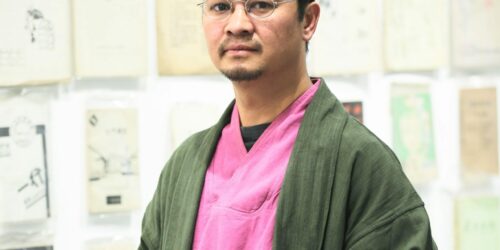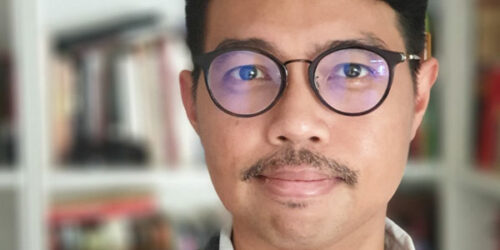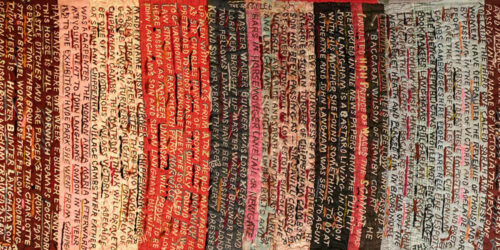
Translator Yuki Tejima shares her experience on a three-day translation workshop with experienced literary translator Ginny Tapley Takemori and critically acclaimed author Sayaka Murata.
A group of ten early-career translators worked with Ginny Tapley Takemori to produce a shared translation of a short text by Sayaka Murata, discussing options and challenges as they went along. The workshop took place in the Waseda International House of Literature (The Haruki Murakami Library) at Waseda University.
Yuki Tejima recalls working through the translation for Sayaka Murata’s short story Culture Shock with her peers. She leads us into a discussion on how to translate one of the bizarre elements of a town called Culture Shock and shares the insights she gained during this process.
The workshop is generously supported by the Tadashi Yanai Initiative for Globalizing Japanese Humanities at UCLA and Waseda University and is run in collaboration with the National Centre for Writing.
![]()
Translating Sayaka Murata in Tokyo
Written by Yuki Tejima
“Wait, so are the ants dead or alive?”
“Dead, right?”
“Is there a better way to say ‘hardened ants’?”
“How about ‘packed’ ants?”
“That sounds like a suitcase full of ants.”
“Cemented?”
“Plastered?”
“Mm, I don’t know. The building is made up of ants.”
“How can one tell that they’re ants?”
Ten translators are sitting around a U-shaped table in a heated discussion about ants. Finding the right nuance to describe these ants is important – the image, after all, is the creation of Sayaka Murata, one of Japan’s most celebrated authors in translation. Murata’s English translator Ginny Tapley Takemori listens closely, laughing occasionally, as ideas ping-pong around the room.

On a rainy morning in late March as the first of the cherry blossoms begin to tint the Tokyo landscape, ten early-career English translators of Japanese literature have convened from around the country for a three-day translation workshop at the Waseda International House of Literature (Haruki Murakami Library) on the Waseda University campus. Hosted by the National Centre for Writing and the Yanai Initiative, this style of workshop is inspired by the British Centre for Literary Translation Summer School, held each July. Ginny is leading the in-person workshop, and Sayaka Murata herself will be joining us to answer questions, of which we will have many.
The short story we are translating over the course of three days is called Culture Shock, written by Murata as a performance piece for the Manchester International Festival in 2019, where it was performed by multiple actors. The English translation (by Ginny Tapley Takemori) is not yet available in book form.
In the story, a young boy has been dragged by his excessively enthusiastic father – again – from his hometown of Homogeneity where everybody lives a uniform existence, wearing the same clothes, eating the same food, living in identical buildings, to a town called Culture Shock, filled with horrifying sights the boy has never encountered before. A garment made of shells. Foods colored blue. A castle made of sand. A transparent house made of ice.
The passage we translators are discussing, specifically, is this:
その向こうには何万匹もの蟻を固めて作ったビル。
Sono muko niwa nanmanbiki mono ari wo katamete tsukutta biru.
Directly translated: On the other side is a building made with tens of thousands of ants hardened into place.
The Japanese text states the ants have been ‘hardened’ (katamete) into place, affording us no additional information before swiftly moving on to the next bizarre Culture Town fixture.
Our job as translators and workshop participants is to come up with a consensus translation of the short story, meaning we must agree on each word, which, if you know translation, means we must summon our sharpest translator minds as well as the most pleasant, diplomatic aspects of our personalities.
“I was impressed how everyone really engaged with the text and with each other,” Ginny says following the workshop. “All the participants were from quite diverse backgrounds with a wide range of translation experience, which made for very interesting discussions, yet despite occasional disagreements on the best approach, everyone remained respectful of each other (and of me!) and nobody tried to dominate.”

As a participant, I agree that my co-translators are intensely smart and kind, each person a delight to workshop with, line by line, word by word, through Murata’s mysterious story. As with Murata’s famous novels and short story collections, this story jolts us into reexamining what society defines as “normal.” When she writes, Murata often sees the story through the protagonists’ eyes, which allows her to notice what she, the author, might not see on her own. Her characters are thrust into a wild world they are not accustomed to, and as they flail, we readers begin to question our own worldviews.
One participant comments that we need to keep the ‘weirdness’ (a compliment) of Murata’s original text in the English translation, and not smooth it out too much. Another says that English readers might just mark it as a poor translation. We turn to Ginny, who nods gently and shares her experience. When she translates, she takes great care to keep things ‘strange’ when necessary, advising us from smoothing it out too much. But of course, where does one draw the line?
After the workshop, I learn that even Ginny, who has already translated the piece, was met with a few surprises about the story.
“I hadn’t realized that the town of Culture Shock had been created by [the people of] Homogeneity (something like Disneyland on a much larger scale), so that came as a surprise to me!” she says. “I was also very interested how participants placed importance on keeping the narrative voice ‘young’.”
We do not, in fact, know the narrator’s age. Gratefully, we are given the opportunity to ask the author for background information. What does she know about the characters before she sits down to write the story? We are enthralled to learn she draws portraits of her characters and the landscape before writing, giving them the space to move around and interact with one another. Her job, as the author, is to get it down on paper.
In the case of this short six-page piece, the characters have neither names nor extensive back stories, leaving much to the translators’ imagination and interpretation. The author and translator are generous in answering our questions. What is the thing they’re eating in Culture Shock that stains their teeth blue? (We imagine some kind of overripe fruit, the author sees a sugary, artificial-looking bread.)
After three days of mulling over the details of Culture Town, setting it aside for later (fresh new eyes, a translator’s best tool), then coming back to the ants on Day Three, here is the consensus translation we have landed on:
Beyond that a high-rise molded from millions of ants.

Nobody in the classroom is entirely thrilled with it on a sentence level. But we have agreed on it, and I am happy to have arrived at a destination. Somewhere is closer than nowhere.
For early-career translators, these workshops are an invaluable opportunity to learn about the craft and logistics of literary translation. They have taught me to listen, not only to the voice of the text, but to the reasoning behind other translators’ suggestions. One quickly learns that literary translation is a community activity – though perhaps not as literally as in this workshop – and communicating is as essential a skill as translating.
I have been fortunate enough to participate in the National Centre for Writing Emerging Translator Mentorship with mentor Juliet Winters Carpenter in 2021-2022, as well as the BCLT Summer School with workshop leader Asa Yoneda and author Yusho Takiguchi in the summer of 2022. Through these extraordinary experiences, I have somehow transformed from an introvert who one could not pay to raise her hand in class to suddenly having so many questions that I need to remind myself to give others a chance to speak.
I asked Ginny about her past workshop experiences.
“I participated in two BCLT Summer School workshops (2010 with Margaret Mitsutani/Yoko Tawada and 2013 with Jeffrey Angles/Aoko Matsuda) and several BCLT master classes held in Tokyo. These really opened up my world as a translator. Until then I had been used to working alone, and it was a transformative experience to work together with other translators on a text, with the author present. It was illuminating (and humbling!) to see how other translators approached the text, often in quite different ways from me.
I got more of a sense of the boundaries of acceptable translation, and the importance of making the story work in English. It also provided me with networking opportunities, connecting with translators from other languages, and feeling part of the wider translator community. In practical terms, I was subsequently invited to translate several short stories for publication, which gave me a career boost. I tried to bring elements of this experience to our workshop, particularly encouraging participants to discuss and learn from each other, talking about the wider issues surrounding our work, including the business side, and hopefully inspiring everyone to feel part of a mutually supportive community.”
Ginny’s open, generous guidance and her working relationship with Sayaka Murata were a joy to experience.
“Sayaka and I have done a lot of events together over the years,” Ginny says, “so we are quite comfortable working with each other. It was lovely to have her there, and I know that she enjoyed answering questions from participants. I’m very glad that everyone had the opportunity to meet her and ask her questions about her work.”

On the final day of the workshop, Ginny shared her translation of the story, and I know I was not alone in racing to find the ant sentence. In her translation:
Beyond that was a structure formed from tens of thousands of solidified ants.
Solidified. That’s the word I was looking for.
Thank you to the NCW and Yanai Initiative for making this opportunity available to translators in Japan, and to Ginny Tapley Takemori and Sayaka Murata for sharing your time and experience with us.

Yuki Tejima is a Japanese-to-English translator currently based in Tokyo. In 2021, she received a JLPP International Translation Competition Award for her translations of Hiromi Ito and Seiko Tanabe. She participated in the 2021/22 National Centre for Writing Emerging Translator Mentorship with mentor Juliet Winters Carpenter, and her translation of Akutagawa Prize-winning author Risa Wataya is forthcoming this year.
You may also like...
Discover our Link the Wor(l)ds translation workshop
Bilingual poet ko ko thett describes fostering community in online Burmese-English workshops

22nd February 2023
5 tips for translating culture
Essential advice from translator Nazry Bahrawi

30th September 2021
A City is a Living Thing
Mariko Nagai ends her residency in Norwich UNESCO City of Literature

31st July 2016






